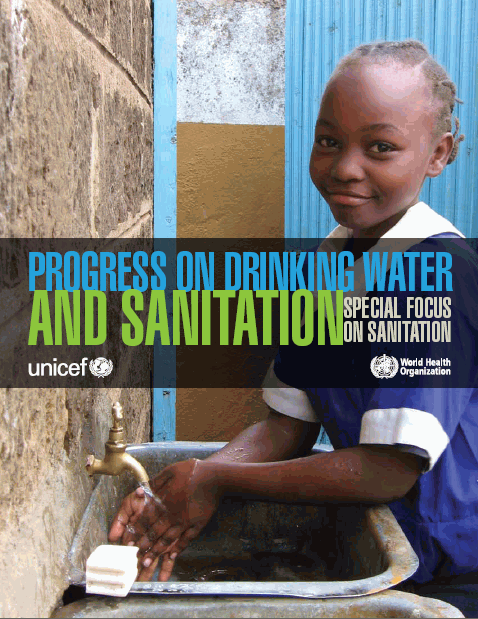Progress on Drinking-water and Sanitation: special focus on sanitation
 |
Progrès sur l'eau potable et l'assainissement - Dossier spécial sur l'assainissement
rapport Jul 2008 ; 58 pages
Ed. UNICEF - New York ; Isbn: 978 92 806 4313 8
Téléchargeable chez l'éditeur
Page de présentation d'un éditeur
Résumé:
Le rapport du JMP, intitulé "Progrès sur l'eau potable et l'assainissement - Dossier spécial sur l'assainissement", évalue - pour la première fois dans l'histoire - le progrès mondial, régional et national en utilisant un concept «échelle» novateur. Cela montre les pratiques d'assainissement avec plus de détails, permettant aux experts de mettre en évidence les tendances des installations sanitaires. De même, l'«échelle de l'eau potable» montre le pourcentage de la population mondiale qui utilise l'eau courante dans une habitation, dans une cour, ou autres sources d'eau améliorées comme les pompes à main. Abstract:
This report details global progress towards the Millennium Development Goal (MDG) target for drinking water and sanitation, and what these trends suggest for the remainder of the Water for Life Decade 2005-2015.
In recognition of the large sanitation deficit, and the declaration of 2008 as the International Year of Sanitation, the report has a special focus on sanitation. It opens with a review of the current status of sanitation and an assessment of progress towards the sanitation target included in the MDGs.
The report also introduces a separate assessment of global, regional and country progress using the ‘sanitation ladder’ – a new way of analysing sanitation practices that highlights trends in using improved, shared and unimproved sanitation facilities and the trend in open defecation. Trends in drinking water coverage are presented in a similar format. They are disaggregated in a ‘drinking water ladder’, which shows the percentage of the world population that uses piped connections into a dwelling, plot or yard; other improved water sources; and unimproved sources.
New data are also presented on the time taken to collect drinking water. The data show the proportion of people that spend more than 30 minutes on a single water-hauling trip and are thus likely to compromise their daily water consumption. In addition, survey data on who usually fetches water are presented to show how this burden is distributed among women, men, girls and boys.
Finally, the report provides a new perspective on progress. The country, regional and global estimates, starting on page 41, include a statistic on the proportion of the population that gained access to improved drinking water and sanitation since 1990. The intention is to recognize those countries that have made significant progress despite major obstacles, including low levels of coverage in 1990, rapid population growth or both. Contents:
2 Foreword
3 The purpose of this report
4 2008: International Year of Sanitation
6 An new way to look at sanitation practices: the sanitation ladder
8 Progress towards the sanitation target
10 Urban-rural disparities in sanitation coverage
12 Improved sanitation
14 Shared sanitation
16 Unimproved sanitation facilities
18 Open defecation
20 A different perspective on progress
22 The drinking water ladder
24 Progress towards the drinking water target
26 Urban-rural disparities in drinking water coverage
28 Piped water on premises
29 Other improved sources of drinking water
30 Unimproved sources of drinking water
32 A different perspective on progress
33 Expanding data collection
38 JMP methodology
41 Country, regional and global estimates on water and sanitation
54 Millennium Development Goals: regional groupings Contents
Mots clefs: |
accès à l'assainissement (CI) (DT) (OP) (ope) , objectifs du millénaire (CI) (DT) (OP) (ope) |
Editeur/Diffuseur: |
|
UNICEF - New York - Etats Unis |
En cas de lien brisé, nous le mentionner à communication@pseau.org